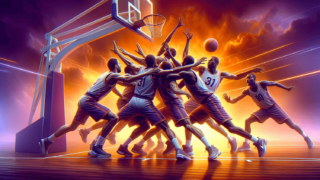
Illegal Screen Rule in Basketball
Written by: Basketball Universe
Last updated:

Oh the sneaky world of setting screens in basketball! Welcome, dear hoop enthusiasts, to another exciting blog post where today, we unravel the nuances of the ‘Illegal Screen Rule in Basketball.’ If you’re eager to become the ultimate expert on this rule, well, you’ve made a slam dunk of a choice! We’re about to dive deep into the nitty-gritty of what makes a screen illegal, examples and consequences and, of course, the controversies and grey areas that spice up the game. So sit back, relax, and let the fun exploration commence!
Illegal Screen Rule in Basketball
The Illegal Screen Rule in basketball refers to the improper execution of a screen, where the screener, while attempting to block or impede an opponent’s movement, violates specific requirements. The illegal contact may result from the screener not being stationary when contact is made, extending their limbs or hips outside their established position, or moving into the path of an oncoming opponent without giving them enough time or space to avoid the collision. An illegal screen typically results in an offensive foul, and the opposing team gains possession of the ball.
Setting the Stage: An Overview of Screens in Basketball
If you’re a basketball aficionado, you’re likely familiar with the concept of screens, hence the spark of interest in the intriguing topic of illegal screens. For the uninitiated, a screen, also known as a pick, is a tactical move where an offensive player stands still to create a barrier between a defender and a teammate with the ball, intending to provide an opportunity for the ball handler to create an open shot or a clear path to the basket. Now that we’ve cleared that up, let’s dive into what happens when screens go rogue and enter the territory of being illegal.
Breaking the Rules: What Makes a Screen Illegal?
The line between a perfectly executed screen and an illegal one can sometimes be quite thin. Understanding these differences is essential for players, coaches, and basketball enthusiasts alike, and that’s where this blog comes in—bringing clarity to this often-confusing aspect of basketball rules. So, let’s take a closer look at some scenarios that can turn a screen into an illegal maneuver.
1. Contact with a Non-stationary Screener
A legal screen requires the screener to remain stationary when making contact with their opponent. If the screener moves or leans into the defender’s path, it can result in an illegal screen. While some movement may be inevitable to establish the screen, the key is for the screener to maintain their position when the actual contact occurs.
2. Strikes and Blocking Fouls
If the screener is not set or extends their limbs (arms, elbows, legs, or hips) to make contact with the defender, it is considered an illegal screen. This unfair contact is usually called a ‘strike’ or a ‘blocking foul’ depending on the specific action. Remember, the goal of a screen is to create a barrier, not initiate contact or impede the defender’s movement in an unscrupulous manner.
3. Insufficient Space for a Screen
In many cases, illegal screens happen when there isn’t adequate space or time provided for the defender to react to the screen. This typically occurs when the screener changes direction to move into the defender’s path at the last moment, limiting the defender’s ability to steer clear of the incoming obstacle. The rule of thumb here is that a screener should provide an opponent at least one step to change their direction or decelerate before making contact.
Dispelling the Confusion: Case Studies in Illegal Screens
Illegal screens can often be a point of contention, given the range of possible scenarios and interpretations that basketball rules extend. To get a solid grasp of illegal screen rules, let’s examine a few case studies and break them down into digestible takeaways.
Case Study 1: The Moving Screen
Imagine a situation where a point guard brings the ball up the court and the team’s center attempts to create a screen for the guard. The center moves laterally to set the screen, but the defender fights through, making contact with the center while they’re still in motion. The result? An illegal screen called on the center due to not being stationary when contact occurred.
Case Study 2: The Extended Elbow Tactic
In this case, the screener sets up correctly by establishing their position, allowing adequate space and time for the defender to react. However, as the defender tries to navigate around the screen, the screener extends their elbow, creating contact outside the frame of their body. Since the screener sought to obstruct the defender through an extension of their elbow—which is not allowed—the screen is considered illegal.
Case Study 3: The No-space Surprise
Picture a small forward setting a screen for a teammate driving to the basket. Just as the teammate approaches, the screener moves to block the defender’s path, not providing enough space for the defender to stop or change directions. Consequently, the defender runs into the screener, resulting in an illegal screen call due to the lack of space for the defender to react.
Bad Pick Consequences: What Happens When an Illegal Screen Occurs?
Now that we’ve explored the ins and outs of illegal screens, it’s important to understand the implications of setting an illegal screen during a game. In the context of basketball rules, an illegal screen typically results in an offensive foul, and depending on how severe the violation is, the screener might incur personal or team fouls. The fouls will stack up throughout the game, with escalating penalties such as free-throw attempts and even ejections, if warranted. Consequently, the defense gains possession of the ball as it is turned over by the offense.
Gray Areas and Conundrums: Unsettled Debates in Illegal Screens
As with many aspects of basketball, there’s an ongoing debate around the subject of illegal screens since there isn’t a one-size-fits-all interpretation for every situation. The ambiguity of criteria can lead to varying outcomes in on-court decision-making, leaving players, coaches, and spectators questioning the ruling. Let’s identify a few of these controversies and how they impact our understanding of illegal screens.
A Matter of Perception: Charge or Block?
In certain situations, it can be difficult for the referee to determine if the responsibility for the contact between the screener and the defender falls on one party or if it’s evenly distributed. Should the referee call an illegal screen (block), or is it the defender’s fault for not adequately adjusting to the situation (charge)? This depends on the referee’s perception and can significantly impact the game by either penalizing the offense or the defense.
How Much Contact is Too Much?
As previously mentioned, some element of movement by the screener is unavoidable when establishing a screen. The question arises, how much contact is permissible before it is deemed an illegal screen? The answer varies depending on the situation and the interpretation of basketball rules by referees. This gray area leads to inconsistencies in officiating and creates confusion among players and fans alike.
Offensive Bias: Spectators’ Dilemma
On occasion, an illegal screen might go unnoticed or unpunished by the referee, leading to some discontent among those watching the game. This might happen as, in the referee’s judgment, the contact wasn’t severe enough to warrant a call or was incidental. Additionally, calls on illegal screens can be subjective and influenced by the style of the game or the refereeing crew.
Mastering the Art: Tips for Perfecting Legal Screens
Now that we’ve dissected the illegal screen rule in basketball, it’s time to refine your understanding and apply it to your game or simply deepen your appreciation as a spectator. Here are some tips to craft the perfect legal screen and enjoy the beautiful game of hoops.
Establish Your Position Early
Effective screens rely on anticipating the play and establishing your body position early. Being set early increases the chances of contact being deemed legal and helps avoid offensive fouls.
Maintain Balance and Solid Footing
Explosive movements during a screen can throw you off balance and create unnecessary contact. Keep your feet shoulder-width apart and hold a strong, balanced stance during the entire process to set an effective and legal screen.
Communicate with Your Teammates
Good communication can be the difference between a successful play and a turnover. Alert your teammates when you’re about to set a screen to ensure they know what’s coming and can maximize the effectiveness of the maneuver.
There you have it, a comprehensive exploration of the illegal screen rule in basketball. Armed with this knowledge, you can now step out onto the court with confidence or watch the game with a vivid understanding and appreciation of the intricacies of screens. Happy hoopin’!
Embracing the Strategy: The Impact of Screens on the Game
Understanding the illegal screen rule is just part of the equation. To truly grasp the importance and impact of screens in basketball, we need to explore how legal screens shape the game, from strategic plays to teamwork dynamics. Let’s investigate some key aspects of this tactical maneuver and how it contributes to the overall gameplay experience.
Creating Space and Scoring Opportunities
The primary goal of a well-executed screen is to create space for the ball handler, opening up opportunities to shoot, drive to the basket, or make an effective pass. This is often achieved by drawing the attention of multiple defenders to one player, thus giving the ball handler a window to exploit the defense and score. As such, mastering the art of legal screens becomes vital for cohesive team play and strategic success.
Forcing Defensive Adjustments
Effective screens often force defensive players to adjust their position, leading to mismatches and throwing the defense off balance. This movement can also create confusion and miscommunication between defenders, allowing the offense to capitalize on these moments to drive an advantage in the game. By recognizing and understanding the illegal screen rule, a team can maximize the potential of this tactic while avoiding unnecessary fouls.
Decoding the Defense: How to Combat Screens
As a defender, confronting a well-executed screen can be daunting. It’s crucial to recognize when an opposing team is trying to set up a screen and understand how to navigate the situation effectively. Here, we’ll dive into some defensive strategies to neutralize offensive screens, keeping the game competitive and exciting.
1. Fighting Through the Screen
When faced with a screen, a common tactic for defenders is to fight through by aggressively stepping around the screener and sticking close to the ball handler. This approach requires quick decision-making and footwork to minimize the separation created by the screen and close down shooting opportunities.
2. Switching on Defense
Another defensive strategy when facing screens is to “switch,” meaning the defender guarding the screener takes over guarding the ball handler, while the original ball handler’s defender moves onto the screener. However, any miscommunication during the switch can lead to mismatches, such as a smaller guard on a larger forward, giving the offense a size or speed advantage.
3. Going Under the Screen
In some instances, a defender might choose to go under the screen by stepping between the screener and the ball handler. This tactic can be effective against ball handlers who struggle with outside shooting, as it limits the driving lanes to the basket while leaving a reasonable gap for the defender to close down on a potentially weak shooter.
4. Trapping the Ball Handler
A more aggressive and riskier approach is to “trap” the ball handler, where both defenders double-team the player with the ball. This strategy can create turnovers or force the ball handler into difficult shots; however, it can also lead to open teammates if the trapped player can find an accurate passing opportunity.
Understanding the illegal screen rule is vital to being a well-rounded basketball player or fan. By incorporating this knowledge in conjunction with offensive and defensive strategies that incorporate screens, you’ll elevate your game and appreciation for the complex, exciting world of basketball.
Frequently Asked Questions
As with any intricate aspect of the game like the illegal screen rule, numerous questions may arise. We’ve compiled a comprehensive list of the most common questions basketball players and fans often ask, supplying concise and informative answers to satiate your burning curiosity.
1. What’s the primary purpose of a screen in basketball?
A screen is a tactical move intended to create a barrier between a defender and an offensive player with the ball. It provides open shot opportunities or a clear path to the basket for the ball handler.
2. How does an official determine if a screen is illegal?
An official considers factors like the screener’s stationary position during contact, extension of limbs, and the amount of space provided to the defender to react. If the contact violates specific requirements, the screen is deemed illegal.
3. What are the consequences of an illegal screen?
An illegal screen typically results in an offensive foul called on the player who set the screen. The screener might also incur personal fouls or team fouls, and the opposing team gets possession of the ball.
4. Can an offensive player call out a screen?
Yes, communication is essential in setting effective screens. Calling out a screen helps alert teammates, allowing them to maximize the effectiveness of the maneuver while avoiding confusion.
5. What techniques can defenders use to counter screens?
Some common techniques against screens include fighting through the screen, switching on defense, going under the screen, and trapping the ball handler. Each strategy has its advantages and risks.
6. How do screens impact defensive strategies?
Screens can force defensive adjustments by creating mismatches and disrupting defenders’ positions. They can cause confusion and miscommunication between defenders, which the offense can exploit to gain an advantage.
7. How much contact is permissible in a legal screen?
Contact in a legal screen must be minimal and incidental, with the screener remaining largely stationary. The interpretation of the level of permissible contact can vary depending on the situation and the officials’ judgment.
8. How can a ball handler utilize a screen effectively?
A ball handler should closely follow the screen to minimize the defender’s recovery time. Recognizing the defender’s reaction to the screen will help the ball handler decide whether to shoot, drive to the basket, or pass to exploit the defense’s adjustment.
9. Can an illegal screen lead to a player’s ejection?
While unusual, an illegal screen could lead to ejection if it’s severe enough, especially if the screen is considered reckless or dangerous. However, typically, an illegal screen results in an offensive foul call and a possible personal or team foul.
10. How can a player perfect the art of setting legal screens?
To set a legal screen, a player should establish an early position, maintain balance and solid footing while holding a strong, stationary stance, and communicate effectively with their teammates throughout the maneuver.
Featured Posts
- No pillar pages found.





